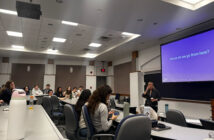
Alexis McGowan
It looked revolting.
An unappetizing, disfigured brown chunk awaited me — not the delicious, molten lava cake the recipe had promised.
With a surgeon’s precision, I cut the cake in half, allowing just enough of the “lava” to ooze out onto the crisp white plate. After I shoot from every angle to make the mushy cake appear mouthwatering, it’s time to edit my work.
I usually begin by increasing the saturation. This technique enhances the colors and makes the food “pop.” If necessary, I adjust the brightness of the photo, sharpen, filter and crop the image. Finally, I post it to my Instagram: @g00deats.
The food Instagram trend has been on the rise for years, but the name of the game has changed.
When I started my account, a simple popsicle on a hot day was exactly what my audience wanted. People wanted to see food that was simple and obtainable.
In summer 2014, I saw a social media movement, and I wanted to be a part of it. One of my first works was a scoop of vanilla ice cream on a sugar cone. I hoped the simple sweetness of my creation would evoke a sentiment of summer, with lush green grasses and flowers blurred in the background.
Today, food is more artistic than edible. Followers want to see rainbow bagels with sprinkles and frosting, unicorn-colored desserts and decadent milkshakes with candy, cake and cookies stacked to the ceiling.
As our society becomes more health conscious, meticulously monitoring what we consume, our food trends become more abstract and unhealthy. Why is this?
When I look at the analytics on my Instagram page, I see an overwhelming difference in the engagement I get on healthy food versus that of unhealthy food. Posts of colorful fruit displays receive significantly fewer comments and likes than photos of a pizza with a garlic knot crust or a plate of decadent cookie dough ice cream sandwiches.
We are beginning to treat food as art. We would rather observe delicious food than eat it. As a society, we are living vicariously through the food Instagram trend — drooling as we scroll through our phones while dining on a plain salad.
This growing trend has also created unimaginable combinations of food because they are aesthetically pleasing, like the “Avolatte,” a latte in a scooped out avocado, or donuts topped with bacon.
Chefs focus on the appearance of their food, just as much as the food’s actual taste. If their dish is “Insta-worthy,” people will flock to their establishment with the hope of getting the perfect Instagram photo.
As a food Instagramer, I am grateful for these bizarre but attractive trends. However, as a picky eater, I am still satisfied with finding beauty in simple foods.
Photography has always played a huge role in my life, and I attribute my early success to my ability to find the natural beauty in simple objects like food.
When I first started my account, I treated every image as a meticulous project. I would walk my dinner through my house to capture its photograph in the perfect lighting. I would even take frozen waffles out of the toaster before they had thawed, in order to capture their golden color before they burned.
Now, even these humble but perfectly posed photos are not what my audience desires. They want to see food that is staged for a photograph.
To keep up with my growing audience, I have often turned to posting the submissions of others — rather than my own photographs — because as a full-time student, I don’t have the ability to eat at Instagram-famous restaurants and take photos of my own food. I do, however, do my best to keep the original intent of @g00deats alive by posting my own photos in combination with others’ submissions.
Some might say I eat with my eyes or my heart and not my stomach. However, @g00deats continues to be a way for me to show people not only the kind of photographer I am, but also who I am as a person: someone who sees the color and beauty out of something that is seemingly ordinary.
I still chose to celebrate every meal in its purest form.
—
Alexis McGowan, ’19, is an associate sports photo editor and lifestyle reporter for The Brown and White. She can be reached at akm219@lehigh.edu.





Comment policy
Comments posted to The Brown and White website are reviewed by a moderator before being approved. Incendiary speech or harassing language, including comments targeted at individuals, may be deemed unacceptable and not published. Spam and other soliciting will also be declined.
The Brown and White also reserves the right to not publish entirely anonymous comments.